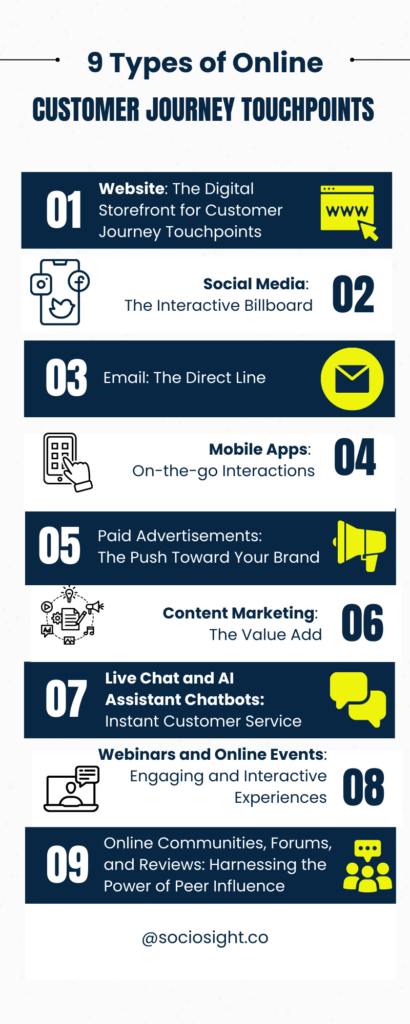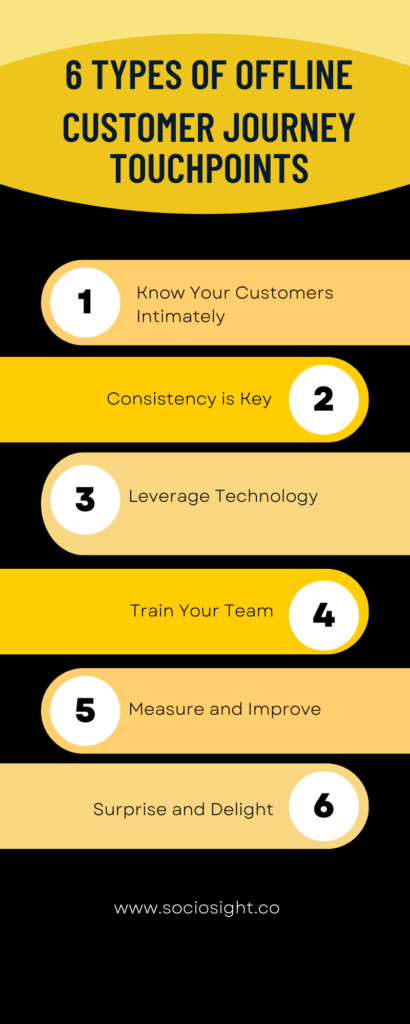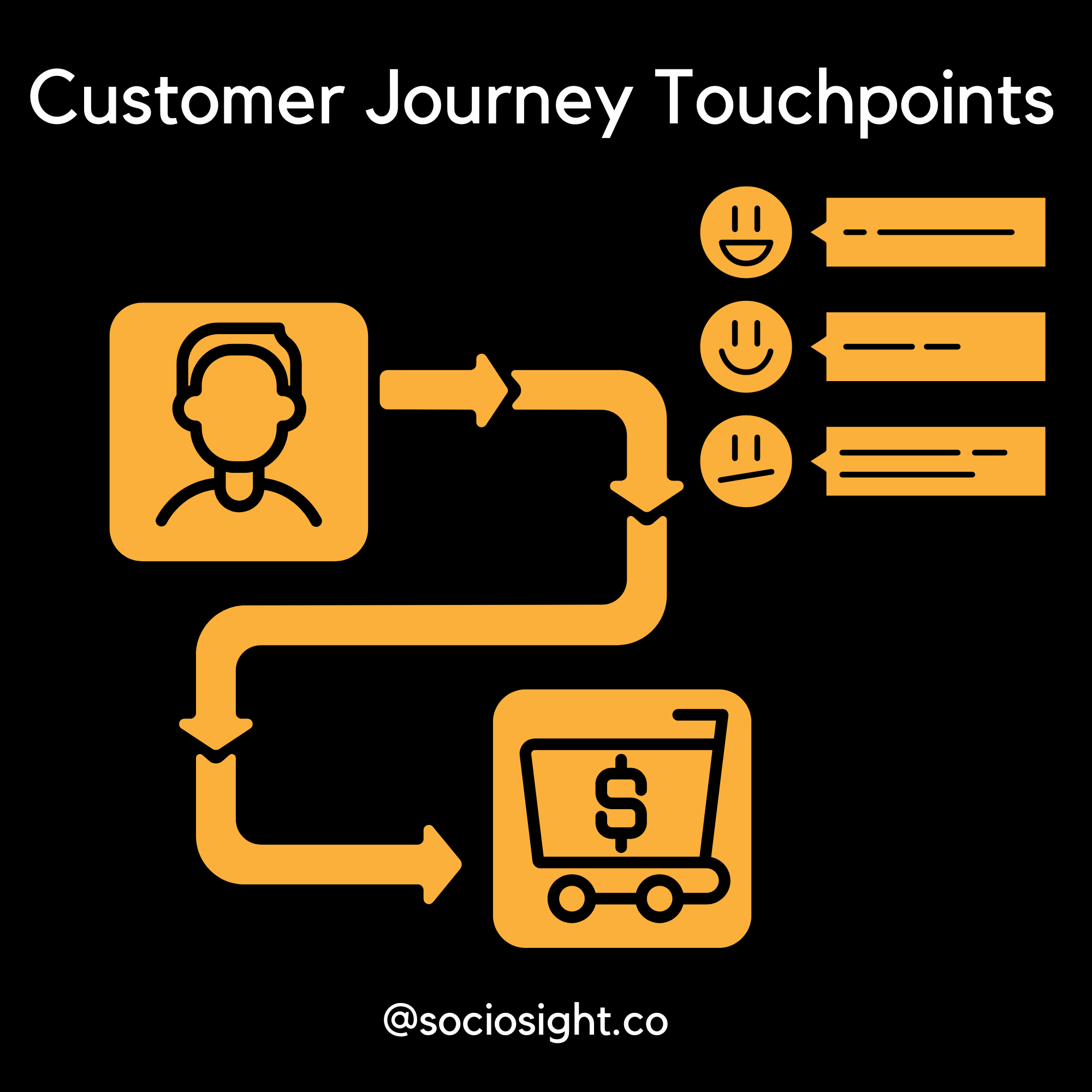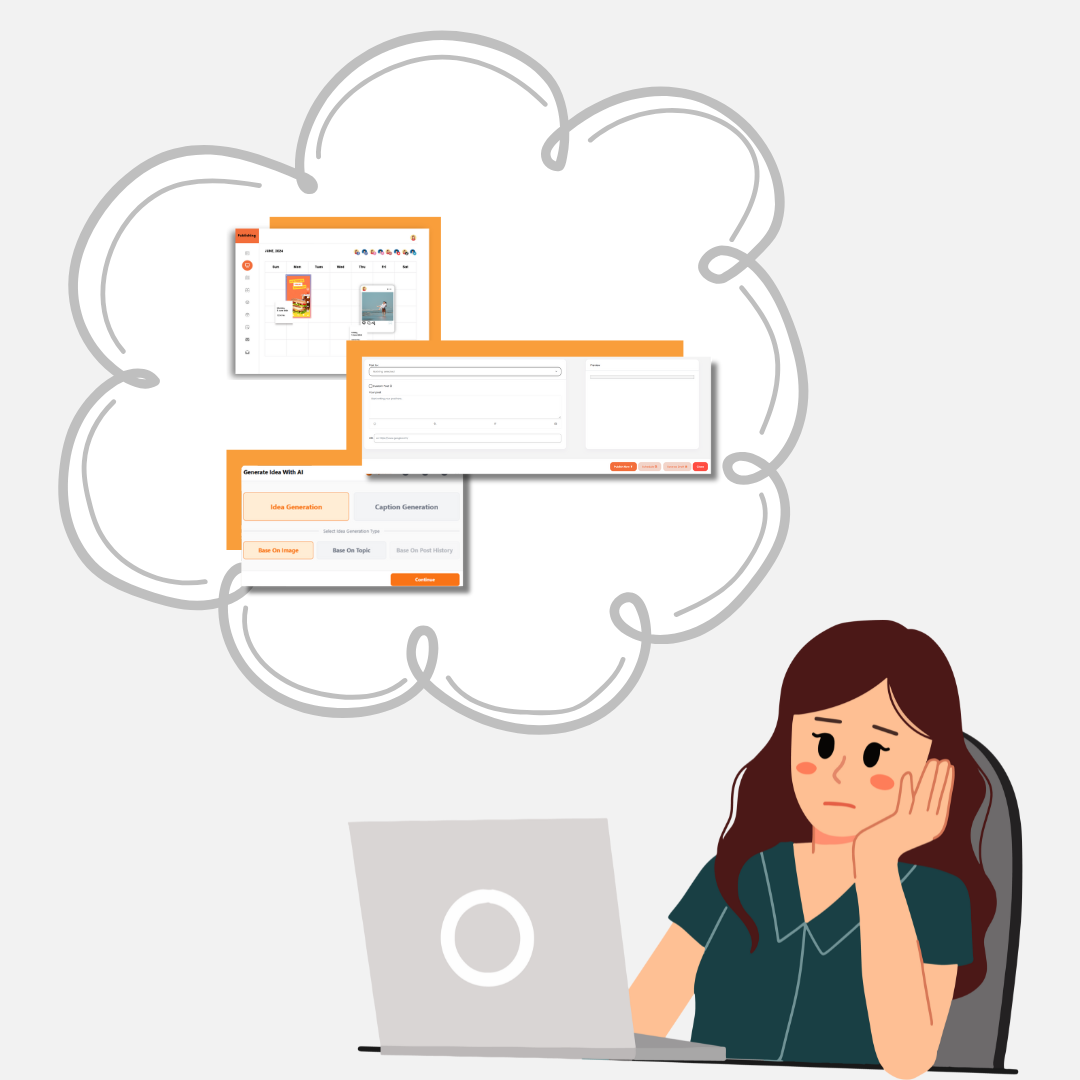As a small business owner, you know that creating an outstanding customer experience is paramount to your success.
But did you know that your customers’ interaction with your brand can make or break their journey?
That’s where customer journey touchpoints come into play.
In our previous blogs, we discussed customer journeys. Also, we discussed how to create a customer journey map.
You can also see some customer journey map examples to help you get started. We also explored how to measure KPIs for customer journeys.
Now, it’s time to dive deeper and focus on the crucial aspect of customer journey touchpoints. These touchpoints can significantly impact your customers, transforming them into loyal, raving brand fans.
In this blog post, we’ll delve into the nitty-gritty of customer journey touchpoints.
We’ll explore the different types of touchpoints, help you identify the most critical ones for your business, and share strategies to optimize them for an exceptional customer experience.
So, buckle up and get ready to harness the power of touchpoints to create a truly remarkable customer journey for your small business!
Pinpointing Your Essential Customer Touchpoints: A Deep Dive into Online and Offline Channels
Have you ever considered how many different ways your target audience interacts with your brand before and after they have become your customers?
Do you struggle with managing multiple social media platforms for your brand's presence?
The Sociosight app can help you simplify the process and save you time. With Sociosight, you can publish, schedule, and monitor posts and engage with your followers across multiple social media platforms, all from one dashboard.
Get started today with a free sign-up!
Register Now for Free

Whether it’s stumbling upon your Instagram ad, visiting your website, receiving an email, or stepping foot into your physical store, every single one of these interactions is a customer journey touchpoint. Understanding and optimizing these touchpoints is the secret sauce to making your customers’ experience unforgettable.
Table of Contents
9 Types of Online Customer Journey Touchpoints
Let’s delve into the world of online customer journey touchpoints first.

Website: The Digital Storefront for Customer Journey Touchpoints
A website is one of the most fundamental online touchpoints for any business, small or large.
Your website is your digital storefront, where the target audience or customers can learn more about your products or services, make purchases, or contact you.
Your website is a vital online touchpoint contributing significantly to the customer’s experience with your brand.
SEO for Better Customer Journey Touchpoints on the Website
Most often, your customers or target audience will find your website via search engines like Google. Therefore, Search Engine Optimization (SEO) plays a vital role.
SEO is optimizing your website to rank higher in search engine results pages (SERPs). This process involves using relevant keywords, creating high-quality content, and ensuring your website is user-friendly and responsive.
Optimizing your website for SEO makes it more discoverable to people searching for your products or services. This optimization increases the likelihood of attracting potential customers to your digital storefront.
Moreover, a well-optimized website ensures a smooth and engaging experience for your visitors, which can contribute to higher conversion rates.
Remember, the easier people find and navigate your website, the more likely they will engage with your brand and become loyal customers. So, investing in a well-designed and SEO-optimized website is crucial for creating positive customer journey touchpoints.
Analytics Tools for Customer Journey Touchpoints Improvement
Alongside SEO, utilizing analytics tools like Google Analytics to understand how your customers interact with your website is vital. These tools can provide insights into which pages your website users visits most often, how long they stay on those pages, and what actions they take. This data can also show where users drop off, allowing you to pinpoint areas of your website hindering your customer journey touchpoints.
For instance, if many users leave your website from a specific page, it might indicate that the page needs to be more explicit or provide the expected information. On the other hand, if users spend much time on a specific page, that could mean the content is engaging and helpful.
Analyzing this data lets you improve your website and optimize the user experience. These improvements can range from adjusting the website layout, modifying the navigation menu, or enhancing the page loading speed.
Remember, each change you make based on these insights helps to improve your customer journey touchpoints. The goal is to ensure that your website attracts potential customers and provides an engaging and seamless experience that encourages them to stay and convert.
Social Media: The Interactive Billboard
Now more than ever, social media platforms function as interactive billboards where you can connect with your customers meaningfully and personally.
Whether it’s Instagram, Facebook, LinkedIn, Twitter, Pinterest, YouTube, or TikTok, each platform offers unique opportunities for customer engagement.
They’re spaces where you can engage directly with your target audience or customers, share updates about your products or services, and even provide customer service.
Remember, each social media platform has its unique culture and audience, so adapting your content and engagement strategy is crucial.
For example, Instagram is great for sharing visually appealing product images or behind-the-scenes content, while LinkedIn is more suitable for sharing industry-related articles or company news.
However, managing multiple social media accounts and creating engaging content can be challenging. That is why you need compelling copywriting for social media to attract your audience’s attention.
You may also need social media management tools like the Sociosight App, with a feature to schedule your posts ahead of time, manage all your social media content in one place, respond to post comments, and craft compelling messages that resonate with your audience.
Remember, each post, comment, or share on your social media platforms is a touchpoint contributing to your customer’s overall perception of your brand. Ensure you’re making the most of these opportunities to connect with your audience and influence their journey with your brand.
Email: The Direct Line
Email is a direct line to your customers, allowing you to reach them with personalized messages and offers. It’s an effective way to keep your brand top-of-mind, promote new products or services, or share valuable content.
To make the most of this touchpoint, segment your email list based on factors like customer behavior or purchase history. This segmented list will allow you to send highly targeted emails that resonate more deeply with your audience.
Mobile Apps: On-the-go Interactions
Mobile apps have become an important touchpoint in today’s digital-first landscape.
As a small business owner, you might have a dedicated mobile app or leverage popular third-party apps like WhatsApp or Messenger for customer service.
Mobile apps provide a convenient, on-the-go way for customers to interact with your brand, whether browsing products, purchasing, or seeking support.
So, if you have a dedicated mobile app, ensure your app is intuitive, fast, and provides a seamless user experience to encourage continued use.
Paid Advertisements: The Push Toward Your Brand
Online advertisements are crucial touchpoints on social media platforms, search engines, or other websites. They introduce your brand’s target audience or potential customers and push them toward your website or online store.
You can tailor your ads to appear to a specific demographic, making them a great way to reach your target audience. Tracking the success of these ads (through click-through rates, conversion rates, etc.) can offer valuable insights about your customers and their behavior.
Content Marketing: The Value Add
Content marketing is another central online customer journey touchpoint.
Whether it’s blog posts, e-books, videos, podcasts, or infographics, content marketing provides valuable and engaging information to your target audience and customers, which can help position your business as a reliable resource.
If you want to optimize your content marketing as one of your customer journey touchpoints, you may need to implement the content batching strategy to streamline your content creation process.
Content batching involves creating a large amount of content in a single session, which can then be scheduled for publication over time. This strategy lets you maintain a consistent presence across your digital platforms, ensuring your customers are constantly engaged and informed.
Suppose you are writing a blog post or a homepage as one of your customer journey touchpoints to interact with your website. You should ensure that your copywriting for the website can make or break your customer’s experience. You can incorporate one of the copywriting formulas like AIDA or FAB.
The AIDA copywriting formula –Attention, Interest, Desire, and Action – is a classic approach that works well for various types of content. It’s all about grabbing attention, sparking interest, creating desire, and prompting action.
On the other hand, the FAB copywriting formula, which stands for Features, Advantages, and Benefits, is especially effective for product descriptions, service offerings, and handling objections. This formula helps you communicate the unique selling points of your products or services in a way that resonates with your customers.
Live Chat and AI Assistant Chatbots: Instant Customer Service
In today’s fast-paced digital world, customers expect quick and efficient responses. They will likely leave your site and look elsewhere if they can’t find the necessary information.
That’s where live chat and chatbots come in. These customer journey touchpoints allow businesses to provide instant customer service, answering queries and solving problems in real-time.
Live chat is typically operated by human customer service representatives, offering a personal touch. However, it’s not always feasible to have a team available 24/7.
Enter chatbots. These AI-powered tools are designed to interact with customers, answer simple queries, and guide users toward relevant information. While they may lack the human touch, they make up for it in availability and efficiency.
That said, not all chatbots are created equal.
Basic ones follow pre-programmed rules, responding to specific prompts with set answers.
But then we have AI Assistants, a more advanced form of chatbot. They use machine learning and natural language processing to understand and respond to user queries, and this means they learn from previous interactions, providing increasingly personalized responses.
So, while both live chat and chatbots (including AI Assistants) offer instant customer service, their applications vary. Choosing between them will depend on your business needs, resources, and the level of customer service you aim to provide.
Webinars and Online Events: Engaging and Interactive Experiences
Webinars and online events have become common customer journey touchpoints, especially in a post-pandemic world.
They can be incredibly engaging and informative, helping to build a relationship with your audience.
These events can offer deep dives into your products or services, provide educational content, or showcase customer testimonials. They offer a unique opportunity to interact with customers in real time, answer their questions, and build a stronger connection.
Remember, each touchpoint offers a unique opportunity to engage with your customers and guide them further along their journey. Optimize each one and maintain a consistent brand experience across all channels.
Online Communities, Forums, and Reviews: Harnessing the Power of Peer Influence
The power of online communities, forums, and reviews is immense in customer journey touchpoints. People tend to trust the opinions of their peers, often seeking advice or feedback from these online platforms before making a purchasing decision.
Consider online communities and forums as digital roundtables. Places like Reddit, Quora, Facebook Group, LinkedIn groups, or niche-specific forums are where potential customers gather to discuss their interests, problems, and needs. Your presence in these spaces enhances your brand visibility and lets you engage directly with your audience, gathering valuable insights about their preferences and concerns.
Online reviews, on the other hand, play a crucial role in the modern customer journey touchpoints, acting as the virtual equivalent of word-of-mouth.
According to a survey by BrightLocal, 82% of consumers read online reviews for local businesses, with 52% of 18-54-year-olds saying they ‘always’ read reviews. Hence, managing your online reputation through review platforms like Google My Business, Yelp, or industry-specific review sites can significantly impact your customers’ perceptions and decision-making process.
Moreover, reviews can also be an essential touchpoint for customer service.
Responding to positive and negative reviews shows that you value your customer’s opinions and are committed to improving their experiences. It’s an excellent opportunity to display your brand’s personality and customer-centric approach, strengthening the bond with your audience across their customer journey touchpoints.
6 Types of Offline Customer Journey Touchpoints
Indeed, while digital channels are crucial, offline touchpoints also play a significant role in shaping customer experiences.
Here are a few examples:

- Physical Stores/Showrooms: These are the places where customers can directly interact with your products or services. Your store’s layout, cleanliness, and overall ambiance contribute to the customer’s experience.
- Events/Trade Shows: Participating in industry events, trade shows, or local fairs allows potential customers to get to know your brand. These events can offer face-to-face interactions, product demonstrations, and direct feedback.
- Print Advertising: Despite the rise of digital media, traditional print advertising in newspapers, magazines, or billboards can still reach a significant audience. They can be especially effective in local markets.
- Direct Mail: Sending mail directly, such as catalogs, coupons, or samples, can offer a personalized touchpoint. This method can be effective, especially when targeted based on customer data and preferences.
- In-person Customer Service: This could be in-store assistance, product demonstrations, or after-sales service visits. In-person interactions offer a chance to deliver superior service, solve issues immediately, and build a stronger relationship with the customer.
- Word of Mouth: Never underestimate the power of personal recommendations. Happy customers can become your brand ambassadors, influencing their family and friends to try your products or services.
Maintaining consistency and high-quality service across all online and offline touchpoints is critical to a successful customer journey. Each touchpoint should be an opportunity to enhance the customer’s experience and deepen their relationship with your brand.
Emotion-Driven Touchpoints: How to Authentically Connect with Your Customers and Leave a Lasting Impression
Imagine walking into a store where the staff recognizes you, understands your preferences and makes you feel valued. That’s the power of emotion-driven customer journey touchpoints. This power is the secret sauce that turns ordinary customers into raving fans, leaving a lasting impression that keeps them returning.
Emotion-driven touchpoints are about connecting with your customers or target audience in marketing on a personal level. It’s not just about selling products or services but building relationships, evoking feelings, and creating memorable experiences. It could be a heartfelt thank you note with an order, a thoughtful and personalized recommendation, or a swift and empathetic response to a customer’s concern.
Understanding customers’ needs, desires, and emotions would allow you to create these powerful connections. Use the insights you’ve gathered from your customer personas and their journey maps to identify opportunities to engage with your customers authentically. For instance, if your customers value sustainability, a touchpoint could be sharing behind-the-scenes content about your eco-friendly practices.
Remember, authenticity is critical. Customers can tell when a brand is genuinely interested in their well-being versus merely trying to make a sale.
Focusing on emotion-driven customer journey touchpoints will make your customers feel valued and foster loyalty and advocacy for your brand. After all, customers who feel emotionally connected to a brand are likelier to recommend it to others and stay loyal over time.
Fine-Tuning Your Touchpoints: Expert Strategies to Elevate the Customer Experience
Each touchpoint can make or break your customer relationship in the vast landscape of customer interactions. Therefore, fine-tuning these touchpoints to elevate the customer experience is critical.
Here’s how you can achieve that:
- Know Your Customers Intimately: Understanding your customers’ needs and pain points is paramount. Use customer data and feedback to gain insights into their behavior and preferences. This insight will allow you to tailor your customer journey touchpoints to deliver personalized experiences.
- Consistency is Key: Ensure a seamless transition between different customer journey touchpoints. Consistency in your messaging, tone of voice, and visual branding across all channels helps build a solid and recognizable brand identity.
- Leverage Technology: Use technology to optimize your touchpoints. For instance, AI-powered chatbots can respond instantly to customer queries, while CRM systems can help manage customer relationships and interactions more effectively.
- Train Your Team: Employees are crucial in shaping the customer experience. Regularly train your team to deliver excellent customer service and ensure they’re well-versed with your products and services.
- Measure and Improve: Use tools like customer satisfaction surveys, Net Promoter Scores, or customer effort scores to measure the effectiveness of your touchpoints. Regularly assess this feedback and make necessary improvements to your strategies.
- Surprise and Delight: Going the extra mile can turn a satisfied customer into a loyal one. Surprise your customers with unexpected perks, discounts, or personalized messages to delight them and deepen their connection with your brand.
Remember, the ultimate goal of fine-tuning your customer journey touchpoints is to create an exceptional customer experience. When done right, it results in satisfied customers, boosts customer loyalty, and drives business growth.
Unlocking the Potential of Touchpoints: Inspiring Case Studies Across Customer Journey Stages
Behind every successful small business lies an effective strategy that harnesses the power of customer journey touchpoints.
Let’s explore three fascinating case studies demonstrating how optimizing touchpoints at different customer journey stages can turn a small business into a beloved brand.
Case Study 1: “Homey Crafts: An Online Store Captivating Audiences at the Awareness Stage”
In the vast internet marketplace, a small craft store, “Homey Crafts,” struggled to get noticed. They had a unique product range of handmade crafts but needed to reach and captivate their target audience at the awareness stage.
The store focused on content marketing as its primary touchpoint at this awareness stage.
They started a blog that posted weekly DIY craft tutorials and stories behind various traditional craft techniques. Also, they implemented SEO strategies to reach their audience further, optimizing their blog posts with relevant keywords.
In addition, they also started a YouTube channel, posting craft tutorial videos and behind-the-scenes glimpses of their creative process. These channels raised awareness about their brand and added value for their target audience, turning casual viewers into potential customers.
By prioritizing these touchpoints in the awareness stage, Homey Crafts saw a significant increase in website traffic and a growth in their online following.
Case Study 2: “EcoStyle: A Fashion Brand Winning Hearts at the Consideration Stage”
EcoStyle, a sustainable fashion brand, has raised awareness about its products. However, they needed to strengthen their touchpoints at the consideration stage to convert interested target audiences into customers.
They revamped their website to offer detailed information about their sustainable practices, fabric sources, and the artisans behind their products. They also started a podcast discussing sustainable fashion trends and the importance of eco-friendly choices.
EcoStyle also introduced a virtual fitting room feature on their website, allowing customers to visualize how the clothes might look on them. This feature reduced the uncertainty that often comes with online shopping, making customers more confident to buy their products.
With these improved customer journey touchpoints at the consideration stage, EcoStyle saw reduced cart abandonment rates and increased sales conversion rates.
Case Study 3: “TechEase: A Tech Support Service Excelling at the Decision Stage”
TechEase, a tech support service, was proficient in informing potential customers of their services and presenting why they were superior. However, the decision stage, where potential customers decide to avail their services, needed more powerful touchpoints.
TechEase started offering a no-obligation, one-time free tech consultation to ease decision-making. This touchpoint allowed potential customers to experience their service quality first-hand, making it easier to decide.
They also implemented a chatbot on their website to answer FAQs and help guide customers through different service options. This instant customer service touchpoint provided customers with the information they needed when they needed it, facilitating a smoother decision-making process.
By enhancing these decision-stage touchpoints, TechEase saw an increase in new customers and customer retention rates.
Conclusion: Seize the Power of Touchpoints to Drive Your Small Business Growth and Customer Satisfaction
In the orchestra of your customer journey, touchpoints are the keynotes that create a pleasant experience. They are your opportunities to connect, impress, and build lasting customer relationships.
Remember, each online and offline touchpoint, from social media to in-store interactions, contributes to the overall customer experience. And the secret to success lies in personalization, emotional connection, and continual improvement.
Don’t just passively manage these customer journey touchpoints. Seize them as opportunities to create an extraordinary customer journey that elevates your small business.
We’d love to hear about your experiences and successes with optimizing customer journey touchpoints. Please share your thoughts in the comments section below or post on Instagram and tag us @sociosight.co. Let’s learn and grow together in this journey of customer experience excellence!











